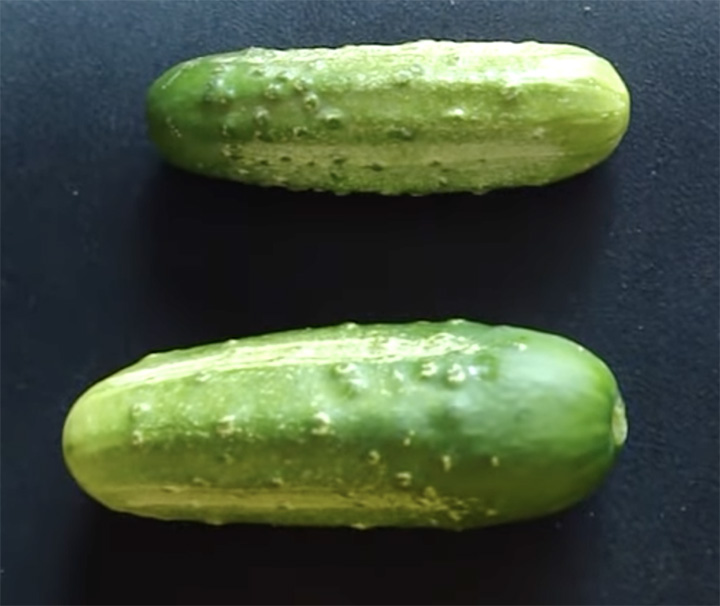Next to tomatoes, cucumbers are the most common vegetable grown in home gardens. There are many varieties of cucumbers. ‘Kirby cucumber’ is a general term for pickling cucumbers.
Quick Growing Guide for the Kirby Cucumber
| Plant Type | Annual | Resistant to | Varies by variety |
| USDA Hardiness Zone | 2a-11b | Maintenance | Moderate |
| Season | Late spring through frost | Soil Type | Fertile |
| Exposure | Full sun | Soil pH | 6-6.8 |
| Time to Maturity | 50-70 days | Soil Drainage | Well drained |
| Water Needs | heavy | Companion Plants | Sweet Alyssum, Yarrow, Dill, Rye, Buckwheat, Radishes, Coneflower, Borage, Anise Hyssop, Mountain Mint |
| Planting Depth | ½ inch deep | Don’t Plant Near | Lettuce, Arugula, Beets |
| Spacing | 6 feet | Family | Cucurbitaceae |
| Height | 8-18 inches | Genus | Cucumis |
| Spread | 3-8 feet | Species | sativus |
| Common Pests and Diseases | Alternaria leaf blight, Anthracnose Aphids, cucumber beetles, others | Variety | Varies, common ones are national pickling cucumber, supremo hybrid, burpee pickler, max pack |
What Is a Kirby Cucumber?
Kirby cucumber is an old-fashioned pickling cucumber variety. While the actual variety is difficult to find now, pickling cucumbers, in general, are often referred to as Kirby cucumbers.
Cultivation and History
Cucumbers are originally from the Himalayas and Northern Thailand. Kirby cucumbers are named after a New York farmer named Norval E. Kirby, who released them in 1920. The cucumbers quickly became known for their sweet, crunchy flavor and hardiness. People started pickling the cucumbers. They were grown commercially for pickling and were so good that people began referring to any picking cucumber as a Kirby-type cucumber. In the late 1930s, the ‘National Pickling’ cucumber overtook the Kirby cucumber as the top commercial pickling cucumber, but the name Kirby cucumbers stuck as a generic term for pickling cucumbers.
Characteristics of the Kirby Cucumber
Growth Habit
Kirby-type cucumbers are vining cucumbers. The length of the vine varies by variety.
Fruit Size, Color, Texture, Taste
Kirby cucumbers are small, growing three to six inches long. They have thick, bumpy skin and small seed cavities. They are short and squat, with a rounded tip. Pickling cucumbers are crisp, and the thick skin helps them stand up to the pickling process. Kirby cucumbers vary in color from bright green to dark green, with a few cream-colored varieties. They can be eaten fresh with a sweet, mild flavor, but the majority are pickled.
Read this article for the best tasting cucumbers.
Cucumber Type
Kirby cucumbers are open-pollinated. Pickling cucumbers, in general, may be hybrids or open-pollinated.
Plants Resistant To These Diseases
This varies widely by the variety of cucumber. The actual Kirby cucumber is not resistant to anything, according to Cornell University. Other pickling cucumbers can be resistant to a number of cucumber diseases.
Growing Kirby Cucumbers
Light
Pickling cucumbers need at least six hours of sun and will do better in eight hours or more.
Soil
Kirby cucumbers need soil with lots of organic matter in it. If planting in a pot, use a potting soil made for vegetables. If you cannot find a vegetable potting soil, mix half general potting soil and half compost together and use that. In the ground, mix three inches of compost into the top six inches of topsoil. The soil must drain well, or the cucumber will get root rot and die.
Planting
Pots should be at least twelve inches deep and fourteen inches in diameter. Fill with a potting soil mixture as described above. No hill is necessary in a pot. Plant four seeds in the pot or two cucumber plants.
For in-ground seeds, you should form a hill of soil about four inches tall and four inches in diameter. Plant three to four seeds ½ inch deep in the hill.
When the seedlings emerge and have two true leaves, pinch off the weakest two seedlings and let the strongest two grow from the hill or pot. Do not pull the weak seedlings out, or you will damage the roots of the survivors.
For transplants, plant them in the hill by digging a hole large enough for the root ball to fit in. Be sure any peat pots are completely buried in the soil, or they will wick moisture out of the plant into the wind and kill it.
For complete instructions on starting seeds and planting transplants, see my article.
When to Plant Kirby Cucumbers?
Plant Kirby cucumbers when all danger of frost is past. They will not tolerate frost. The soil temperature should be at least 60 degrees F, or the seeds will not germinate.
Water
Keep the soil moist around the cucumber vines. If the soil dries out, the cucumbers will become bitter. You should water as frequently as needed to keep the soil moist. I use an inexpensive moisture meter to make sure the soil stays moist without it getting soggy.
Temperature
Cucumbers are subtropical fruit. They grow best when the temperature is between 75-85 degrees F. You can extend the season by three to four weeks by starting seeds indoors and then transplanting them outside when the temperature has warmed.
Fertilizer
Cucumbers are heavy feeders. Follow the recommendations of a soil test before planting the cucumbers. If you do not have a soil test, spread three pounds of 5-10-10 over 100 square feet where you will plant your cucumbers. Mix it in the top inch of soil with a rake.
After the cucumbers are planted, you will fertilize them twice more. One week after blooms begin, spread one pound 33-0-0 alongside the cucumber vines and about six inches to one side of them. Mix the fertilizer into the top one to two inches of soil. Repeat in three weeks. You should not fertilize the cucumber vines again, or they will grow lots of vine and not have very many cucumbers.
Read my article for more on fertilizing cucumbers.
Why Plant Kirby Cucumbers?
Kirby cucumbers are ideal for pickling. They are also tasty when eaten fresh. If you can only plant one kind of cucumber, a Kirby cucumber makes sense. Slicing cucumbers can be pickled but won’t be as crisp as a Kirby cucumber.
Where to Buy Kirby Cucumbers?
The old Kirby cucumber is very difficult to find. Pickling cucumbers can be bought online at Amazon, Burpee, Johnny’s Selected Seeds, and other seed dealers. Transplants can be purchased at big box stores like Home Depot and most nurseries.
You can read my article for information on great pickling cucumber varieties.
Pest & Diseases
Cucumbers have several pests and diseases. The most common diseases are powdery mildew, downy mildew, and Anthracnose. Other problems are Alternaria leaf blight, Belly rot, Cercospora leaf spot, Fusarium wilt, Septoria leaf spot, and various viruses.
The most common pests are cucumber beetles and aphids. You can find a more complete list of pests here.
Both pests and diseases can generally be managed with good cultural practices. Healthy cucumber plants are more resistant to both diseases and pests. Take care not to over-fertilize because the lush, succulent growth attracts more pests and diseases than a properly fertilized vine attracts.
Harvesting
Pickling cucumbers are generally harvested when they are three to four inches long. Some varieties get as long as six inches long. To harvest pickling cucumbers, cut the stem about ¼ inch above the cucumber. Do not pull or twist the stem, or you can injure the plant. Harvest every day. The more cucumbers you harvest, the more cucumbers the plant will produce.
Storage
Cucumbers are best stored in a humid, dark area that is about 55 degrees F. Few homes have this. Store for up to a week in the crisper drawer of the refrigerator. If you are pickling the cucumbers, it is best to pickle them as soon as possible after you pick them so they retain their nutrients and crispness.
Common Uses of Kirby Cucumber
These cucumbers are grown for pickling, although they can be eaten fresh. Here is a typical recipe for dill pickles. Be sure and follow the recipe exactly, or you risk food-borne illness. This recipe yields 7-9 pints.
Ingredients
- 8 pounds of 3- to 5-inch pickling cucumbers
- 2 gallons water
- 1¼ cups canning or pickling salt (divided)
- 1½ quarts vinegar (5 percent)
- ¼ cup sugar
- 2 quarts water
- 2 tablespoons whole mixed pickling spice
- 3 tablespoons whole mustard seed
- About 14 heads of fresh dill OR 5 tablespoons dill seed
Directions
Wash your cucumbers and cut off the blossom ends. Discard those ends, but leave ¼ inch long stem attached.
Take two gallons of water and dissolve ¾ cup of salt in it. Pour over the cucumbers and let them stand for twelve hours. Drain the cucumbers.
Combine the vinegar, ½ cup salt, sugar, and two quarts of water in a large saucepan. Tie the pickling spices in a clean white cloth and put them in the saucepan. Heat the mixture to a boil.
Fill the pint jars with the cucumbers and add one teaspoon mustard seed and 1 ½ heads fresh dill (or 1 ½ teaspoon dill seed) to each pint jar.
Cover with the boiling pickling liquid and leave ½ inch headspace. Adjust the lids and process for ten minutes in a boiling water bath. Recipe from Clemson Cooperative Extension.
Final Verdict
In conclusion, Kirby pickles are pickling cucumbers. They need full sun, fertile soil with lots of organic matter, and consistent moisture to produce lots of pickles. Be sure and pick your Kirby cucumbers every day once they start having cucumbers to maximize the harvest. While there are several pests and diseases that attack cucumbers, good management practices will keep most of them from bothering your Kirby cucumbers.






